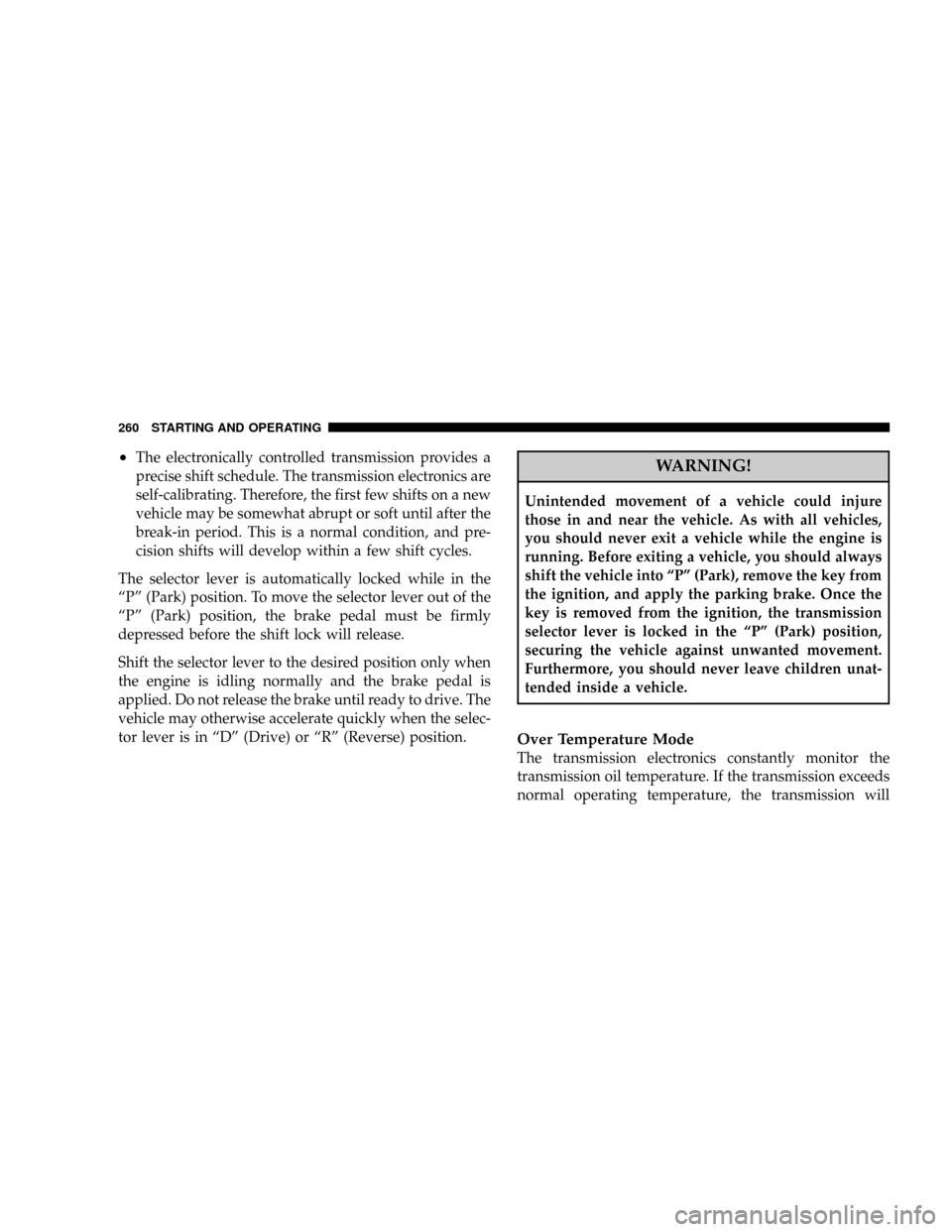2008 DODGE CHARGER oil temperature
[x] Cancel search: oil temperaturePage 166 of 466

The gauge pointer will likely indicate a higher tempera-
ture when driving in hot weather, up mountain grades,
or when towing a trailer. It should not be allowed to
exceed the upper limits of the normal operating range.
CAUTION!
Driving with a hot engine cooling system could
damage your vehicle. If temperature gauge reads (H),
pull over and stop the vehicle. Idle the vehicle with
the air conditioner turned off until the pointer drops
back into the normal range. If the pointer remains on
the ªHº, and you hear a chime, turn the engine off
immediately, and call for service.
WARNING!
A hot engine cooling system is dangerous. You or
others could be badly burned by steam or boiling
coolant. You may want to call a service center if your
vehicle overheats. If you decide to look under the
hood yourself, see Section 7 of this manual. Follow
the warnings under the Cooling System Pressure Cap
paragraph.
9. Turn Signal Indicators
The arrow will flash with the exterior turn signal
when the turn signal lever is operated.
NOTE:A continuous chime will sound if the vehicle is
driven more than 1 mile (1.6 km) with either turn signal
on.
166 UNDERSTANDING YOUR INSTRUMENT PANEL
Page 260 of 466

²The electronically controlled transmission provides a
precise shift schedule. The transmission electronics are
self-calibrating. Therefore, the first few shifts on a new
vehicle may be somewhat abrupt or soft until after the
break-in period. This is a normal condition, and pre-
cision shifts will develop within a few shift cycles.
The selector lever is automatically locked while in the
ªPº (Park) position. To move the selector lever out of the
ªPº (Park) position, the brake pedal must be firmly
depressed before the shift lock will release.
Shift the selector lever to the desired position only when
the engine is idling normally and the brake pedal is
applied. Do not release the brake until ready to drive. The
vehicle may otherwise accelerate quickly when the selec-
tor lever is in ªDº (Drive) or ªRº (Reverse) position.WARNING!
Unintended movement of a vehicle could injure
those in and near the vehicle. As with all vehicles,
you should never exit a vehicle while the engine is
running. Before exiting a vehicle, you should always
shift the vehicle into ªPº (Park), remove the key from
the ignition, and apply the parking brake. Once the
key is removed from the ignition, the transmission
selector lever is locked in the ªPº (Park) position,
securing the vehicle against unwanted movement.
Furthermore, you should never leave children unat-
tended inside a vehicle.
Over Temperature Mode
The transmission electronics constantly monitor the
transmission oil temperature. If the transmission exceeds
normal operating temperature, the transmission will
260 STARTING AND OPERATING
Page 376 of 466

Change Engine Oil
The oil change indicator system will remind you that it is
time to take your vehicle in for scheduled maintenance.
Refer to ªMaintenance Scheduleº in Section 8 of this
manual for information on this system.
NOTE: Under no circumstances should oil change
intervals exceed 6,000 miles (10 000 km) or 6 months,
whichever occurs first.
Engine Oil Selection
For best performance and maximum protection under all
types of operating conditions, the manufacture only
recommends engine oils that are API certified and meet
the requirements of DaimlerChrysler Material Standard
MS-6395.
American Petroleum Institute (API) Engine Oil
Identification Symbol
This symbol means that the oil has
been certified by the American
Petroleum Institute (API). The
manufacture only recommends
API Certified engine oils.
Engine Oil Viscosity (SAE Grade) Ð 2.7L and 5.7L
Engines
SAE 5W-20 engine oil is recommended for all operating
temperatures. This engine oil improves low temperature
starting and vehicle fuel economy.
376 MAINTAINING YOUR VEHICLE
Page 377 of 466

The engine oil filler cap also shows the recommended
engine oil viscosity for your engine. For information on
engine oil filler cap location, refer to the ªEngine Com-
partmentº illustration in this section.
NOTE:Vehicles equipped with a 5.7L engine must use
SAE 5W-20 oil. Failure to do so may result in improper
operation of the Multiple Displacement System (MDS).
Refer to ªMulti Displacement Systemº under ªStarting
and Operatingº for more details.
Lubricants, which do not have both, the engine oil
certification mark and the correct SAE viscosity grade
number should not be used.
Engine Oil Viscosity (SAE Grade) Ð 3.5L Engine
SAE 10W-30 engine oil is preferred for use in 3.5L
Engines for all operating temperatures.The engine oil filler cap also shows the recommended
engine oil viscosity for your engine. For information on
engine oil filler cap location, refer to the ªEngine Com-
partmentº illustration in this section.
Lubricants, which do not have both, the engine oil
certification mark and the correct SAE viscosity grade
number should not be used.
Synthetic Engine Oils
You may use synthetic engine oils provided the recom-
mended oil quality requirements are met, and the recom-
mended maintenance intervals for oil and filter changes
are followed.
Materials Added to Engine Oil
The manufacturer strongly recommends against the ad-
dition of any additives (other than leak detection dyes) to
the engine oil. Engine oil is an engineered product and its
performance may be impaired by supplemental addi-
tives.
MAINTAINING YOUR VEHICLE 377
7
Page 386 of 466

The external lock cylinders should be lubricated twice a
year, preferably in the fall and spring. Apply a small
amount of a high quality lubricant such as MopartLock
Cylinder Lubricant or equivalent directly into the lock
cylinder.
Windshield Wiper Blades
The rubber edges of the wiper blades and the windshield
should be cleaned periodically with a sponge or soft cloth
and a mild nonabrasive cleaner. This will remove accu-
mulations of salt or road film.
Operation of the wipers on dry glass for long periods
may cause deterioration of the wiper blades. Always use
washer fluid when using the wipers to remove salt or dirt
from a dry windshield.
Avoid using the wiper blades to remove frost or ice from
the windshield. Keep the blade rubber out of contact with
petroleum products such as engine oil, gasoline, etc.
Windshield Washers
The windshield washer fluid reservoir is located in the
front of the engine compartment. Be sure to check the
fluid level at regular intervals. Fill the reservoir with
windshield washer solvent (not radiator antifreeze) and
operate the system for a few seconds to flush out the
residual water.
When refilling the washer fluid reservoir, take some
washer fluid and apply it to a cloth or towel and wipe
clean the wiper blades, this will help blade performance.
To prevent freeze-up of your windshield washer system
in cold weather, select a solution or mixture that meets or
exceeds the temperature range of your climate. This
rating information can be found on most washer fluid
containers.
386 MAINTAINING YOUR VEHICLE
Page 394 of 466

Care should be taken in installing quick connect fittings
to insure they are properly installed and fully connected.
See your authorized dealer for service.
Brake System
In order to assure brake system performance, all brake
system components should be inspected periodically.
Suggested service intervals can be found in the ªMainte-
nance Scheduleº in Section 8 of this manual.
WARNING!
Riding the brakes can lead to brake failure and
possibly an accident. Driving with your foot resting
or riding on the brake pedal can result in abnormally
high brake temperatures, excessive lining wear, and
possible brake damage. You wouldn't have your full
braking capacity in an emergency.
Brake And Power Steering Hoses
When the vehicle is serviced for scheduled maintenance,
inspect surface of hoses and nylon tubing for evidence of
heat and mechanical damage. Hard and brittle rubber,
cracking, tears, cuts, abrasion, and excessive swelling
indicate deterioration of the rubber. Particular attention
should be made to examining those hose surfaces nearest
to high heat sources, such as the exhaust manifold.
Insure nylon tubing in these areas has not melted or
collapsed.
Inspect all hose connections such as clamps and cou-
plings to make sure they are secure and no leaks are
present.
NOTE:
²Often, fluid such as oil, power steering fluid, and
brake fluid are used during assembly plant operations
to facilitate the assembly of hoses to couplings. There-
fore, oil wetness at the hose-coupling area is not
394 MAINTAINING YOUR VEHICLE
Page 445 of 466

Auto Down Power Windows................ 35
Auto Unlock, Doors....................... 31
Auto Up Power Windows.................. 36
Automatic Dimming Mirror................. 84
Automatic Door Locks...................30,31
Automatic Headlights.................... 124
Automatic Oil Change Indicator..........169,178
Automatic Temperature Control (ATC)......... 242
Automatic Transaxle
Special Additives...................... 397
Automatic Transmission...........262,267,396,397
Adding Fluid......................397,423
Autostick.........................270,272
Fluid and Filter Changes................. 397
Fluid Change......................... 397
Fluid Level Check...................... 396
Fluid Type........................... 423
Gear Ranges.......................262,268
Overdrive........................... 264Shifting..........................262,267
Special Additives...................... 397
Torque Converter...................... 266
Automatic Transmission Limp Home
Mode...........................266,271,272
Autostick...........................270,272
Axle Fluid............................. 423
Axle Lubrication (Axle Fluid)............... 423
Ball Joints............................. 385
Battery............................... 381
Emergency Starting..................... 356
Jump Starting......................... 356
Keyless Transmitter Replacement (RKE)....... 25
Location..........................357,381
Bearings.............................. 398
Belts, Drive............................ 378
Belts, Seat............................41,77
Body Mechanism Lubrication............... 385
INDEX 445
10
Page 450 of 466

Oil Filter Disposal...................... 378
Oil Selection.......................376,419
Oil Synthetic......................... 377
Operation............................ 74
Overheating.......................... 345
Starting............................. 255
Temperature Gauge..................... 165
Engine Oil Viscosity...................376,377
Enhanced Accident Response Feature.......... 61
Entry System, Illuminated.................. 20
Ethanol............................... 320
Event Data Recorder...................... 63
Exhaust Gas Caution..............75,76,322,387
Exhaust System.......................75,387
Exterior Folding Mirrors................... 85
Exterior Lighting........................ 123
Exterior Lights.......................... 78
Filler Location Fuel...................... 323Filters
Air Cleaner.......................... 379
Air Conditioning....................248,384
Engine Fuel.......................... 379
Engine Oil........................378,421
Engine Oil Disposal.................... 378
Flashers
Hazard Warning....................... 344
Turn Signal......................78,127,166
Flash-To-Pass........................... 128
Flat Tire Changing....................... 346
Flooded Engine Starting................... 257
Floor Console.......................... 153
Fluid, Brake........................... 423
Fluid Capacities......................... 419
Fluid Leaks............................. 78
Fluid Level Checks
Automatic Transmission................. 396
Brake............................... 395
450 INDEX